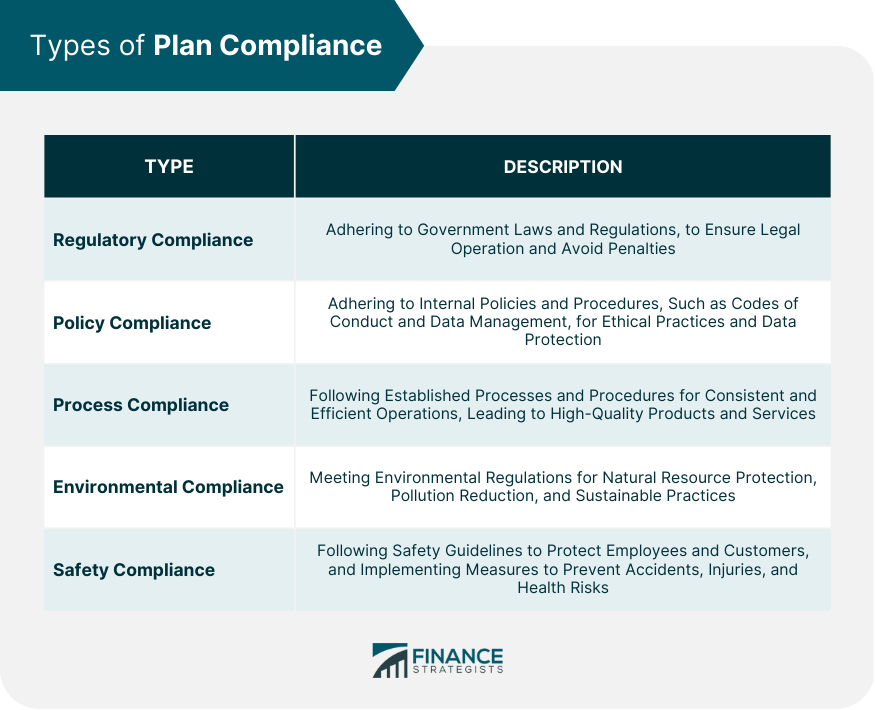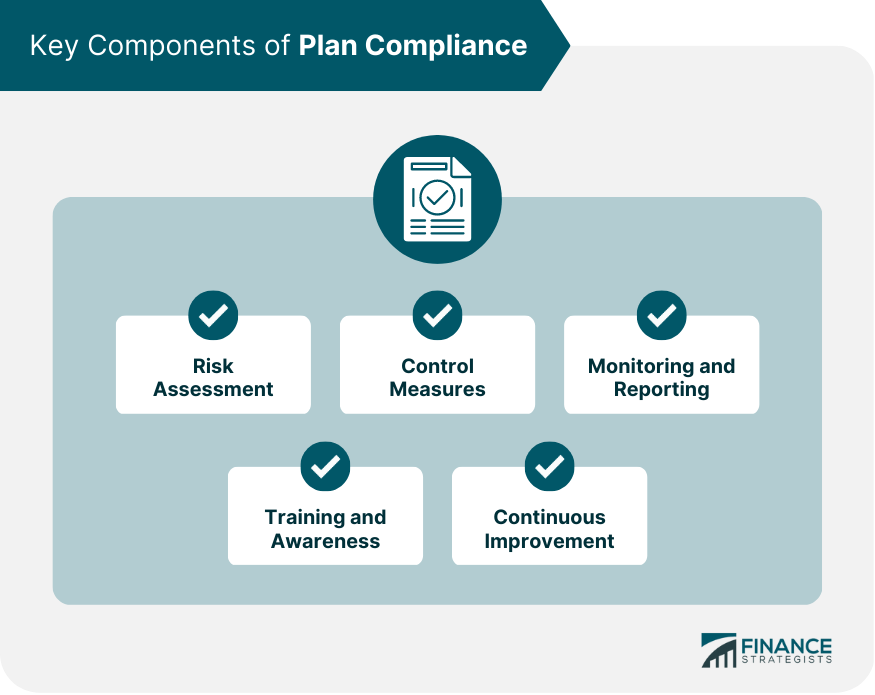Plan compliance refers to the adherence to the rules, regulations, and best practices governing retirement plans, ensuring that these plans meet the required standards set by the relevant authorities. Plan compliance involves fulfilling fiduciary responsibilities, submitting necessary reports, providing participants with required disclosures, and maintaining the tax-qualified status of the plan. By achieving and maintaining plan compliance, individuals and employers can secure retirement benefits and avoid potential penalties, legal actions, and financial losses associated with non-compliance. Different types of plan compliance exist, depending on the specific rules and regulations that apply to an organization. Regulatory compliance involves adhering to laws and regulations set by government agencies. It ensures that organizations meet the necessary requirements to operate legally and avoid penalties or sanctions. Policy compliance refers to the adherence to internal policies and procedures established by an organization. These policies may include codes of conduct, privacy policies, and data management protocols that help maintain ethical practices and protect sensitive information. Process compliance involves following established processes and procedures within an organization. This ensures consistency, efficiency, and effectiveness in operations, leading to higher quality products and services. Environmental compliance focuses on meeting environmental regulations and standards. Organizations must adhere to rules that protect natural resources, reduce pollution, and promote sustainable practices. Safety compliance entails following safety guidelines and standards to protect employees and customers. Organizations must implement measures to prevent accidents, injuries, and health risks, fostering a safe working environment. Retirement plans, particularly those that offer tax advantages, are subject to various federal and state regulations. In the United States, the Employee Retirement Income Security Act (ERISA) is the primary legislation governing retirement plans. ERISA sets standards for plan fiduciaries, reporting and disclosure requirements, and rules for participation, vesting, and funding. In addition, the Internal Revenue Service (IRS) oversees the tax aspects of retirement plans, and the Department of Labor (DOL) is responsible for enforcing ERISA regulations. To maintain plan compliance, individuals and employers must adhere to these regulations, which may include: a. Ensuring that the plan meets the qualification requirements set forth by the IRS b. Submitting annual reports and financial statements to the appropriate regulatory agencies c. Regularly reviewing plan documents and amending them as needed to reflect changes in the law or plan provisions d. Providing participants with required disclosures, including summary plan descriptions, summary annual reports, and individual benefit statements A successful plan compliance program consists of several key components that work together to ensure adherence to relevant rules and regulations. Risk assessment involves identifying, evaluating, and prioritizing potential compliance risks. Organizations must assess the likelihood and impact of noncompliance to develop appropriate mitigation strategies. Control measures are the policies, procedures, and practices put in place to mitigate identified risks. They help organizations manage and reduce the likelihood or impact of noncompliance events. Monitoring and reporting involve tracking the effectiveness of control measures and reporting compliance status to stakeholders. Regular monitoring allows organizations to identify areas for improvement and take corrective actions when necessary. Training and awareness programs educate employees about compliance requirements and their responsibilities. These programs help to create a culture of compliance, reduce the risk of noncompliance, and empower employees to make informed decisions. Continuous improvement is the ongoing evaluation and enhancement of a plan compliance program. Organizations must regularly review and update their compliance efforts to ensure they remain effective and aligned with evolving regulations and industry standards. A well-designed plan compliance program is essential for organizations to effectively manage their compliance responsibilities. The first step in implementing a plan compliance program is identifying the relevant laws, regulations, and standards that apply to the organization. This process involves researching and compiling a comprehensive list of compliance requirements. A compliance framework is a structured approach to managing compliance responsibilities. It outlines the roles, responsibilities, processes, and controls needed to ensure adherence to applicable rules and regulations. Once a compliance framework is established, organizations must design and implement control measures to address identified risks. This may involve creating policies, procedures, and processes that help to mitigate the potential for noncompliance. Clear roles and responsibilities must be assigned to individuals or teams within the organization to oversee and manage compliance efforts. This ensures accountability and promotes a culture of compliance throughout the organization. Ongoing monitoring is crucial for maintaining the effectiveness of a plan compliance program. Organizations should establish procedures for tracking, measuring, and reporting compliance performance to identify areas for improvement and take corrective actions as needed. Organizations face several challenges in implementing and maintaining effective plan compliance programs. Regulatory landscapes are constantly evolving, making it difficult for organizations to stay current with new requirements. Companies must invest time and resources in monitoring changes and updating their compliance programs accordingly. Consistency in implementing compliance measures across the organization can be challenging, especially for larger organizations with multiple departments or locations. Clear communication, training, and monitoring are essential for maintaining uniformity in compliance efforts. Implementing and maintaining a plan compliance program requires significant resources, including time, personnel, and financial investments. Organizations must balance these demands with other operational priorities and may struggle to allocate sufficient resources to compliance efforts. Despite robust compliance programs, human errors and instances of noncompliance can still occur. Organizations must be prepared to handle these situations, identifying root causes and taking appropriate corrective actions to prevent future occurrences. Gaining and maintaining stakeholder support for compliance initiatives can be challenging, as it often requires changes in organizational culture and practices. Companies must communicate the value of compliance programs to stakeholders and demonstrate their commitment to upholding the highest standards. Failure to maintain plan compliance can have serious consequences for both individuals and employers, including: a. Disqualification of the plan, which may result in the loss of tax advantages and benefits for participants b. Fines and penalties imposed by regulatory agencies, which can be significant and may increase with the severity of the violation c. Legal actions and lawsuits filed by plan participants or regulatory agencies, leading to additional financial burdens and reputational damage d. The risk of jeopardizing retirement goals, as non-compliance can negatively impact the plan's ability to provide adequate benefits to participants Implementing best practices can help organizations overcome challenges and establish successful plan compliance programs. Incorporating compliance into an organization's culture helps to create an environment where adherence to rules and regulations is seen as a core value. Leaders should promote a culture of compliance by setting expectations, providing resources, and reinforcing the importance of compliance efforts. Technology can streamline and automate many aspects of plan compliance, including risk assessment, monitoring, and reporting. By leveraging technology solutions, organizations can improve the efficiency and effectiveness of their compliance programs. Collaboration with regulatory authorities and industry peers can help organizations stay current with evolving compliance requirements and best practices. Engaging in industry forums, attending conferences, and participating in regulatory consultations can provide valuable insights and guidance. A proactive approach to plan compliance involves anticipating potential risks and addressing them before they become issues. Organizations should encourage employees to identify and report potential compliance concerns, fostering a culture that prioritizes proactive risk management. Compliance programs must be regularly reviewed and updated to ensure they remain effective and relevant. Organizations should conduct periodic audits and assessments to identify areas for improvement and make necessary adjustments to their plan compliance efforts. The value of effective plan compliance is significant for organizations, as it helps to maintain a strong reputation, avoid legal penalties, and ensure operational efficiency. By understanding the different types of plan compliance, implementing a comprehensive compliance program, and adopting best practices, organizations can successfully navigate complex regulatory landscapes and foster a culture of integrity and accountability.Definition of Plan Compliance
Types of Plan Compliance
Regulatory Compliance
Policy Compliance
Process Compliance
Environmental Compliance
Safety Compliance

Regulatory Requirements of Plan Compliance
Key Components of Plan Compliance
Risk Assessment
Control Measures
Monitoring and Reporting
Training and Awareness
Continuous Improvement

Implementing a Plan Compliance Program
Identifying Compliance Requirements
Establishing a Compliance Framework
Designing and Implementing Controls
Assigning Roles and Responsibilities
Ensuring Ongoing Monitoring
Challenges in Plan Compliance
Keeping Up-to-Date With Regulatory Changes
Ensuring Consistent Implementation
Managing Resource Constraints
Addressing Human Errors and Noncompliance
Maintaining Stakeholder Support
Consequences of Non-Compliance
Best Practices in Plan Compliance
Embedding Compliance into Corporate Culture
Leveraging Technology Solutions
Collaborating With Regulators and Industry Peers
Fostering a Proactive Compliance Mindset
Regularly Reviewing and Updating Compliance Programs
Conclusion
Plan Compliance FAQs
Plan compliance refers to the adherence of a company's employee benefit plans to federal and state laws and regulations.
The types of plan compliance include ERISA compliance, IRS compliance, and Department of Labor compliance.
The components of plan compliance typically include plan design and documentation, participant disclosures, funding, and reporting and disclosure.
Some challenges of plan compliance include keeping up with changing laws and regulations, ensuring accurate and timely reporting, and dealing with potential audits or penalties.
Plan compliance is important because it helps protect the interests of plan participants and ensures that companies are following legal and ethical standards for managing their employee benefit plans.
True Tamplin is a published author, public speaker, CEO of UpDigital, and founder of Finance Strategists.
True is a Certified Educator in Personal Finance (CEPF®), author of The Handy Financial Ratios Guide, a member of the Society for Advancing Business Editing and Writing, contributes to his financial education site, Finance Strategists, and has spoken to various financial communities such as the CFA Institute, as well as university students like his Alma mater, Biola University, where he received a bachelor of science in business and data analytics.
To learn more about True, visit his personal website or view his author profiles on Amazon, Nasdaq and Forbes.











